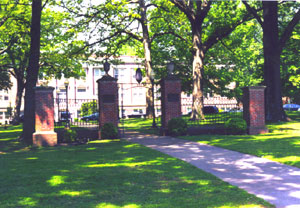
Lambuth University
On December 2, 1843, the Memphis Conference of the Methodist Episcopal Church received a charter from the Tennessee General Assembly authorizing the establishment of a young women's preparatory school and college to be named the Memphis Conference Female Institute (MCFI). Located in Jackson on five acres of land that had been the site of a Presbyterian college, the new college soon won renown for its quality education as a result of the work of its presidents, Dr. Lorenzo Lea, Dr. Amos W. Jones, and Dr. A. B. Jones, who succeeded his father. During the Civil War, the college buildings served as a hospital for Union troops, while the school continued to operate in the home of Dr. Amos Jones.
The degree of Mistress of English Literature was conferred on the early graduates who completed the English course; those who completed additional work in Latin or one of the modern languages received the A.M. A bachelor of arts degree was added in 1912, as was a Conservatory of Music and a School of Expression, Art, and Domestic Art.
In the early twentieth century financial difficulties led to the decision to make the institution coeducational. The MCFI charter was amended on January 3, 1923, to provide for coeducation and to change the name to Lambuth College in honor of the Reverend Walter R. Lambuth, M.D. To expand its facilities, the college moved from the corner of Chester and Institute streets to its present location on Lambuth Boulevard. In the fall of 1924 Lambuth College admitted its first class of male students.
Lambuth College had five presidents from 1924 to 1991, when the college achieved university status. Dr. Richard E. Womack became the first president in 1924 and served until 1952. Although his tenure spanned the difficult years of the Great Depression and World War II, several new buildings were erected on the campus. Dr. Luther L. Gobbel assumed the duties of the presidency in October 1952 and served until the fall of 1962. In July 1962 the Board of Trustees elected Dr. James S. Wilder Jr. as Lambuth's third president. In 1964 Wilder initiated a master plan known as the “Great Challenge” that resulted in a period of extraordinary academic and fiscal growth. During this period, Lambuth added four new buildings, including the science building, which contains the Mid-South's finest planetarium. Dr. Harry W. Gilmer became the fourth president of Lambuth College in June 1980 and served until October 1986. Under Gilmer's leadership, the college launched a $15 million sesquicentennial campaign for scholarships, endowment, and campus renovation.
In July 1987, Dr. Thomas F. Boyd became the last president of Lambuth College; on July 1, 1991, the school became Lambuth University. Boyd enhanced the academic and athletic programs. When Boyd resigned in April 1996, Dr. Joseph R. Thornton was appointed acting president. After a six-month search, W. Ellis Arnold III, an Arkansas educator, was named president.
Through many generations and with able leaders, Lambuth University, still a United Methodist institution, has continued to educate students with a commitment to the belief that a liberal education must be dedicated to the cultivation of both the mind and spirit.



